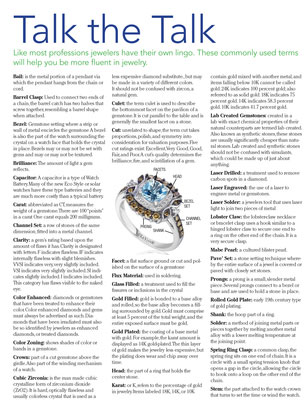Talk the Trade
Like most professions, jewelers have their own lingo. These commonly used terms will help you be more fluent in jewelry:

BAIL: Gemstone setting where a strip or wall of metal encircles the gemstone. A bezel is also the part of the watch surrounding the crystal on a watch face that holds the crystal in place. Bezels may or may not be set with gems and may or may not be textured.
BARREL CLASP: is the metal portion of a pendant via which the pendant hangs from the chain or cord.
BRILLIANCE: The amount of light a gem reflects.
CAPACITOR: A capacitor is a type of watch battery. Many of the new Eco Style or solar watches have these types of batteries and they are much more costly than a typical battery.
CARAT:Abbreviated as CT, measures the weight of a gemstone. There are 100 "points in a carat. One carat equals 200 milligrams.
CHANNEL SET: A row of stones of the same dimensions fitted into a metal channel.
CLARITY: A gem's rating based upon the amount of flaws it has. Clarity is designated with letters. F indicates flawless. IF indicates internally flawless with slight blemishes. VVSI indicated very, very slightly included. VSI indicates very slightly included. SI indicates slightly included. I indicates included. This category has flaws visible to the naked eye.
COLOR ENHANCED: Diamonds or gemstones that have been treated to enhance their color. Color enhanced diamonds and gems must always be advertised as such. Diamonds that have been irradiated must also be so identified as enhanced diamonds, or treated diamonds.
COLOR ZONING: Shows shades of colors or bands in a gemstone.
CROWN: A part of a cut gemstone above the girdle. Also part of the winding mechanism of a watch.
CUBIC ZIRCONIA: Is the man made crystalline form of zirconium dioxide (ZrO2). It is a hard, optically flawless and usually colorless crystal that is used as a less expensive diamond substitute, but may be made in a variety of different colors. It should not be confused with zircon, a natural gem.
CULET: The term culet is used to describe the bottom-most facet on the pavilion of a gemstone. It is cut parallel to the table and is generally the smallest facet on a stone.
CUT: Unrelated to shape, the term cut takes proportions, polish and symmetry into consideration for valuation purposes. Five cut ratings exist: Excellent, Very Good, Good, Fair and Poor. A cut's quality determines the brilliance, fire and scintillation of a gem.
FACET: A flat surface ground or cut and polished on the surface of a gemstone.
FLUX MATERIAL: Used in soldering.
GLASS FILLED: A treatment used to fill the fissures or inclusions in a crystal.
GOLD FILLED: Gold is bonded to a base alloy and rolled, so the base alloy becomes a filling surrounded by gold. Gold must comprise at least 5 percent of the total weight, and the entire exposed surface must be gold.
GOLD PLATED: The coating of a base metal with gold. For example, the karat amount is displayed as 14K gold-plated. The thin layer of gold makes the jewelry less expensive, but the plating does wear and chip away over time.
HEAD: The part of the ring that holds the center stone.
KARAT: Or K, refers to the percentage of gold in jewelry. Items labeled 18K, 14K or 10K contain gold mixed with another metal, and items falling below 10K cannot be called gold. 24K indicates 100 percent gold. 18K indicates 75 percent gold. 14K indicates 58.3 percent gold. 10K indicates 41.7 percent gold.
LAB CREATED GEMSTONES: Created in a lab with the exact natural properties of their natural counterparts are termed lab created. Also known as synthetic stones, these stones are usually significantly cheaper than natural stones. Lab created and synthetic stones should not be confused with simulants, which could be made up of just about anything.
LASER DRILLED: A treatment used to remove carbon spots in a diamond.
LASER ENGRAVED: The use of a laser to engrave metal or gemstones.
LASER SOLDER: A jewelers tool that uses laser light to join two pieces of metal.
LOBSTER CLAW: The lobster claw necklace or bracelet clasp uses a hook similar to a hinged lobster claw to secure one end to a ring on the other end of the chain. It is a very secure clasp.
MABE PEARL: A cultured blister pearl.
PAVE' SET: A stone setting technique whereby the entire surface of a jewel is covered or paved with closely set stones.
PRONGS: A prong is a small slender metal piece. Several prongs connect to a bezel or base and are used to hold a stone in place.
ROLLED GOLD PLATE: Early 19th century type of gold plating.
SHANK: The hoop part of a ring.
SOLDER: A method of joining metal parts or pieces together by melting another metal alloy with a lower melting temperature at the joining point.
SPRING RING CLASP: A common clasp, the spring sits on one end of the chain. It is a circle with a small spring tension knob that opens a gap in the circle, allowing the circle to hook onto a loop on the other end of the chain.
STEM: The part attached to the watch crown that turns to set the time or wind the watch.
 Book Appointment
Book Appointment 

